Things To Know...
Condition concerns, packing and shipping, insurance and more.
On One Condition?

"Polena"
A Lost Wax Bronze by Angelo Basso
When buying or selling a piece of aged art there are certain issues that may result. Pieces may be either unframed and in mint condition, previously framed or framed. It's natural that as paper ages it may not be as white as the day that the art was printed on it and if a paper piece was previously framed using non-archival mat board it may have discolored on the border from the acid resident in the matting as it aged. Check the bevel cut of the mat and you may notice it's the color of light coffee. Unfortunately, the best older pieces of art were framed years ago before acid free matting was introduced but don't despair as this adds to the authenticity and character. There are fine art conservators skilled in bathing such pieces and restoring them properly should you prefer. I will always give you full and proper descriptions upon request so you can make informed and intelligent choices.
With sculpture, it's appropriate for an older piece to have an aged patina. I'm reminded of an episode of the Antique Road Show. A person wanted a fine Tiffany lamp with a high luster copper base appraised. She was delighted when the expert said that it was worth approximately $60,000. but then was told that had she not continually polished the base it would have been worth $230,000. Something to consider for sure. With that being said I have relationships with foundries that can restore bronze to look like new but it's not the right move.
Framed or Unframed?

"Charwomen"
A lithograph by Norman Rockwell
Our inventory consists of either framed or unframed works of art. Most of our pieces have never been framed and are in mint condition. Our framed works have mostly been professionally framed with the best museum quality materials, but we recognize that you may prefer to design your own framing choices at your local frame shop. If a piece is unframed, we will ship it to you as such. If a piece is framed and you don't care for the frame, we can unframe, leave the hinge tape as to not cause paper loss, and ship. Above all we want your satisfaction! We do not offer framing services.
Packing, Shipping, Insurance?
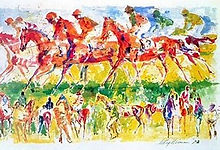
"Racing-1973"
A Serigraph by LeRoy Neiman
In order to get pieces to you safely, we pack each piece with care. Depending on the piece of art or antique collectible we may use bubble wrap, Styrofoam peanuts, craft paper, tissue paper, wooden crates, cardboard boxes, heavy concrete forms, foam injection, etc. Once packed we weigh it and determine the actual cost of shipping. Shipping is not a profit situation for us.
In the unlikely event that there is a damage in transit let us know. Keep the packaging for insurance purposes.
Certificate of Authenticity

"A Toast"
A Serigraph by Giancarlo Impiglia
Certificates provide details about an edition. As an experienced fine art professional I know well the artists work that I have dealt with these many years. My integrity and reputation is tied to the pieces that I offer. While I may have the original certificate from the publisher/artist for a piece of art in some cases there may not be one as the source may have not offered one at inception. Doug Meyer Fine Art certificates are offered upon request, however, since I stand by any piece that I sell.
What's a Serigraph?
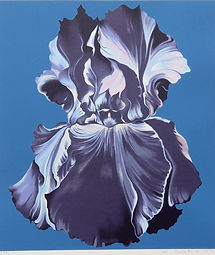
"Blue Tulip on Blue"
A Serigraph by Lowell Nesbitt
Serigraphy is one method of making fine art original prints for which the artist makes a stencil for each color in the picture. Extremely close and consistent registration is crucial in the hand printing of the editions. The method should not be confused with mechanical offset reproduction of images based on photos of original paintings. The materials needed include ink, a screen, a stencil, paper, and a squeegee or other kind of roller. The process of creating the serigraph starts with the screen being pulled tightly. The piece of paper will also be set underneath the screen. This is also the time when the stencil is positioned over the screen. With the screen, stencil, and paper in the right position, the ink will be poured over them. The ink will first be poured over the screen and it will be squeezed through using the squeegee. The product of that process is the serigraph. Due to the how they’re made, serigraphs often feature more texture and color density compared to lithographs. Those differences are quite significant and they matter to buyers.
What's a Lithograph?
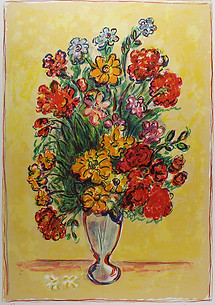
"Bouquet"
A Lithograph by Wayne Ensrud
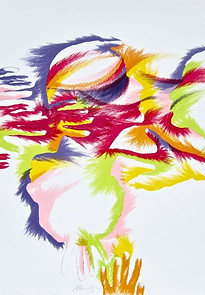
"Budding"
A Lithograph by Marisol Escobar
The word lithography comes from Ancient Greek "lithos", meaning "stone", and "graphein", meaning "to write". It denotes a planographic (flat surface) method and process of printing that makes use of the immiscibility of grease and water, which come to a contact. Lithographs were invented by Alois Senefelder in the Kingdom of Bavaria at the end of the 18th century. Unlike previous methods that relied on various forms of etching, lithography is a more "painterly" medium. Using a set of greasy crayons, the artist draws a mirrored image of the original artwork onto a smooth stone (traditionally limestone) tablet. After the image is recreated to the satisfaction of the artist, this drawing is covered with ink - nonimage (blank) areas, which attract moisture to the plate and repel the lithographic ink, while those that were drawn on - hold it. Water is then wiped onto the unpainted areas as to discourage the ink from smearing. As the tusche (ink) dries, it reticulates. Net-like features are left on the stone and usually show on the final print, a visual feature unique to stone lithography. In order to fixate the image, to make it one with the stone, a solution of gum arabic and nitric acid is prepared on a plate. Applied to the stone, the nitric acid reacts with oleic acid (grease) to create oleomagnate of lime. The acid makes the dark areas sensitized enough to accept ink and reject water, while at the same time does the opposite with the light areas of the surface. A sheet of paper with a high cotton content is then placed over the entire surface by means of a special press. In case of an elaborate color lithograph, this tends to require several different runs with (up to) four different color inks - yellow, red, blue and black. The same paper then needs to be placed over the re-inked plates in a very precise manner as to create a satisfactory lithograph copy. The original method has since evolved quite a bit, but the idea behind it has remained basically the same since the invention of lithograph.
What's an Etching?
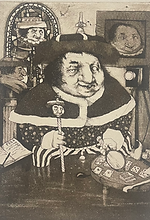
"King of the Me's""
An Etching by Charles Bragg

"Tosca"
An Etching with Aquatint
by Louis Icart
Etching is traditionally the process of using strong acid or mordant to cut into the unprotected parts of a metal surface to create a design in intaglio (incised) in the metal. In modern manufacturing, other chemicals may be used on other types of material. As a method of printmaking, it is, along with engraving, the most important technique for old master prints, and remains in wide use today. In traditional pure etching, a metal plate (usually of copper, zinc or steel) is covered with a waxy ground which is resistant to acid. The artist then scratches off the ground with a pointed etching needle where the artist wants a line to appear in the finished piece, exposing the bare metal. The échoppe, a tool with a slanted oval section, is also used for "swelling" lines. The plate is then dipped in a bath of acid, known as the mordant (French for "biting") or etchant, or has acid washed over it. The acid "bites" into the metal (it undergoes a redox reaction) to a depth depending on time and acid strength, leaving behind the drawing (as carved into the wax) on the metal plate. The remaining ground is then cleaned off the plate. For first and renewed uses the plate is inked in any chosen non-corrosive ink all over and the surface ink drained and wiped clean, leaving ink in the etched forms. The plate is then put through a high-pressure printing press together with a sheet of paper (often moistened to soften it). The paper picks up the ink from the etched lines, making a print and a visible impression around the perimeter of the image. The process can be repeated many times; copies could be printed before the plate shows much sign of wear.
What's a Giclee?
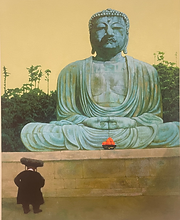
"Encounter"
A Giclee by Charles Bragg
Giclee is a French term meaning “to spray”, referring to how an inkjet printer works and how giclee prints are usually produced. These large format inkjet printers use small spraying devices that can both match color and apply ink precisely, giving artists a high-quality print of their original art. To be able to produce such a faithful reproduction the camera or scanner used to capture or scan the art must be able to do so with a high level of resolution. To compare, most digital photos are recorded at a resolution of 72 DPI on the screen, or “dots per inch,” and the image file of an art print needs to be at least 300 DPI—because the more dots of color that can be printed in a small area, the more detailed your final image will appear.
A True Original!
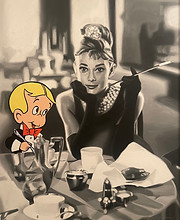
"Breakfast at Tiffany's With Richie""
An original acrylic on canvas
by Clifford Land
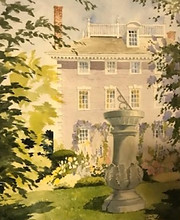
"Lilac House"" An original watercolor on paper
by Dan Britt
An original is a unique one-of-a-kind piece created by an artist. It can be on paper, canvas, board, wood, glass or virtually anything. It may be done with paint, crayon, charcoal, graphite pencil, marker or virtually anything. Since there is only one, these creations tend to be higher priced. It's the very reason why artists reproduce images which can make it more affordable for more collectors to afford and enjoy.
Reproductions may be 'open edition', in the case of posters. These are priced for the lower market and generally have little investment value as they are printed in massive quantities. Limited editions, as described above, do carry more of a cache if they have artful production value, are printed on thick high-grade papers, are hand signed and numbered by the artist and so command higher value. We call these "Original Lithographs" and such because no two pieces are exactly alike since they are each made by hand.
Be careful with what you may be offered in the fine art marketplace as there are many signed posters that may be priced high but are actually glossy, thin papered prints not signed by hand but rather in the printing. Although they don't have high production value some carry value due to the scarcity, beauty and/or import of the artist or piece.
